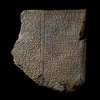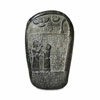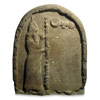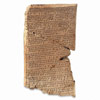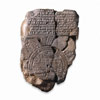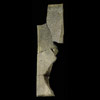
Translation of artifacts provided courtesy
of:
The British Museum 2003
MORE ARTICLES: VIDEO - THE FLOOD TABLET (real player format) Sumerian Culture and the Anunnaki |
Commemorative stone stela
Babylonian, about 900-800 BC
From Babylon, southern Iraq
Set up in honour of a priest by his son
This stela comes from the Temple of Marduk in Babylon. It is a commemorative monument set up in honour of a private individual called Adad-etir. He was an official in the temple, known as 'the dagger bearer', and this stela was erected by his son Marduk-balassu-iqbi. The figures carved in relief on the front represent the father and son together. Their shaven heads show that they are both priests, it being normal in ancient Mesopotamia for a son to adopt his father's profession. There are three divine symbols above the two priests: a winged solar disc representing the sun-god Shamash, a crescent of the moon-god Sin and a lion-headed mace on a pedestal.
The cuneiform inscription includes curses on anyone who may defaces the stela. It translates:
'May Marduk, the great lord, in anger look upon him, and his name and his seed may he cause to disappear. May Nabu, the scribe of all, curtail the number of his days. But may the man who protects it be satisfied with the fulness of life.'
Height: 15 inches
Width: 9 inches
Diameter: 5 inches
L.W. King, Babylonian boundary stones and memorial tablets (London, Trustees of the British Museum, 1912), pp. 115-16, plate XCII
